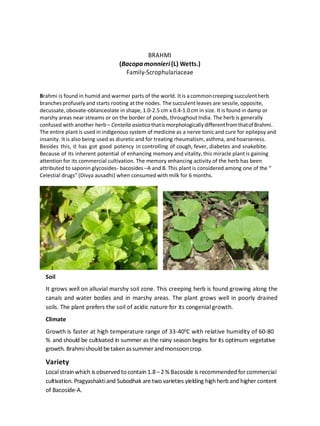
Brahmni Nature herbs
- 1. BRAHMI (Bacopa monnieri (L) Wetts.) Family-Scrophulariaceae Brahmi is found in humid and warmer parts of the world. It is a common creeping succulent herb branches profusely and starts rooting at the nodes. The succulent leaves are sessile, opposite, decussate, obovate-oblanceolate in shape, 1.0-2.5 cm x 0.4-1.0 cm in size. It is found in damp or marshy areas near streams or on the border of ponds, throughout India. The herb is generally confused with another herb – Centella asiatica that is morphologically different from that of Brahmi. The entire plant is used in indigenous system of medicine as a nerve tonic and cure for epilepsy and insanity. It is also being used as diuretic and for treating rheumatism, asthma, and hoarseness. Besides this, it has got good potency in controlling of cough, fever, diabetes and snakebite. Because of its inherent potential of enhancing memory and vitality, this miracle plant is gaining attention for its commercial cultivation. The memory enhancing activity of the herb has been attributed to saponin glycosides- bacosides –A and B. This plant is considered among one of the “ Celestial drugs” (Divya ausadhi) when consumed with milk for 6 months. Soil It grows well on alluvial marshy soil zone. This creeping herb is found growing along the canals and water bodies and in marshy areas. The plant grows well in poorly drained soils. The plant prefers the soil of acidic nature for its congenial growth. Climate Growth is faster at high temperature range of 33-400C with relative humidity of 60-80 % and should be cultivated in summer as the rainy season begins for its optimum vegetative growth. Brahmi should be taken as summer and monsoon crop. Variety Local strain which is observed to contain 1.8 – 2 % Bacoside is recommended for commercial cultivation. Pragyashakti and Subodhak are two varieties yielding high herb and higher content of Bacoside-A.
- 2. Land Preparation The field should be ploughed thoroughly and all the weeds should be taken out. The land should be irrigated a day before planting for establishment of cuttings. If irrigation is not available this should be done with start of monsoon. Manures and fertilizers FYM -10 t well decomposed FYM per ha should be applied to the field at the time of field preparation. Fertilizer - N, P2O5, K 20-100: 60:60 kg/ha of which phosphorus and potash are applied as basal and N in 3 splits. First dose of N is applied with establishment of the crop (30 days after planting) and second dose at 60-70 days and the final dose at 90 days after planting. Planting Brahmi is propagated by stem cutting with nodal roots. The whole plant is cut into small divisions to about 4-5 cm long, each with few leaves and nodes are planted directly in the beds. The cuttings are transplanted in wet soil at a spacing of 20 x 20 cm to get maximum herbage yield. Flood irrigation is provided quickly just after planting. Planting time Planting is done in March – June to get maximum herbage. Ideally, the plants should be transplanted in March-June and are allowed to grow and proliferate through hot and humid months of monsoon till September after which harvesting should be done. The plants can also be maintained in a perennial state with two harvests in a year, the first
- 3. one in June and the other one after monsoon, in October. Irrigation It is essential to water the field after transplanting for survival and establishment. Subsequently irrigation should be applied at 10-12 days interval when there is no rain. Interculture Hand weeding needed at every 15-20 days interval but later on as plants proliferate and form a dense mat of vegetation, weeding may be done occasionally. Major insect: Grasshopper. Spray with Neem based insecticide or 0.2 % Nuvocron. Harvesting and yield The best time for harvesting is between October-November, (after 4-5 months of planting) during which the maximum biomass is produced. Later than this senescence sets in and there is a loss of plant biomass and alkaloid yield. The ratoon crop can be taken favourably. In that case the upper portions including leaves and stems are harvested leaving 4-5 cm from the base for quick regeneration, which is again harvested during June. The October / November harvest yield maximum herb with higher bacoside content. On an average, an yield of 150 q/ha fresh and 30 q dry herbage can be obtained from a single harvest when harvested after September. After the first harvest about 20 q/ha additional dry herbage yield can be obtained from the ratoon crop in June, totaling 50 q/ha dry herb yield in a year. If planted in March the first cutting can be done in June and second cutting in September – October.
- 4. Post harvest management Generally, the traditional method of drying is by spreading the fresh herb on the ground under shade at room temperature. The material should be turned over, alternatively, during drying. The maximum bacoside-A content of dried herb can be maintained by drying the raw materials at 800C in oven for 30 minutes just after harvest. The dried material should be stored in a cool dry room packed in waterproof bags. Care should be taken towards insects and other fungi during storage. Yield/ha Yield of fresh herbs from two harvests 250 q Yield of dry herbs (20% of fresh weight) 50 q Uses Whole herb especially the leaves are used as nervine tonic / memory enhancer. Some of the preparations Brahmighrit, Sarasvatarisht, Brahmivati, Modern medicines such as Mental, Memory plus and Megamind plus use Brahmi as their major component.
